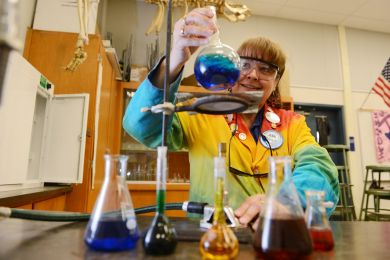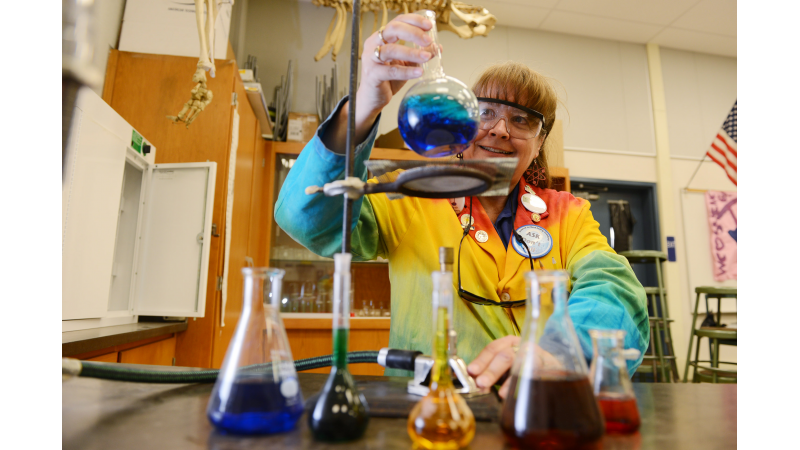 Scientists at the University of California, Davis, issued a report in the summer of 2015 that included an estimate of what the state’s severe drought had cost its agricultural industry: $2.7 billion. The toll of the California drought isn’t news to a group of La Habra middle school students (Fiona, June, Jessica, Angelina, Alma, and Vanessa) and their teacher, Dr. Susan Pritchard. For a series of clever ideas aimed at water conservation, the students are winners in the Lexus Eco Challenge, a national, STEM-themed, teamwork-based contest for grades 6 to 12 sponsored by Scholastic.
Scientists at the University of California, Davis, issued a report in the summer of 2015 that included an estimate of what the state’s severe drought had cost its agricultural industry: $2.7 billion. The toll of the California drought isn’t news to a group of La Habra middle school students (Fiona, June, Jessica, Angelina, Alma, and Vanessa) and their teacher, Dr. Susan Pritchard. For a series of clever ideas aimed at water conservation, the students are winners in the Lexus Eco Challenge, a national, STEM-themed, teamwork-based contest for grades 6 to 12 sponsored by Scholastic.
Read on for a Q&A with the winning team’s teacher advisor!
Discuss your project’s issue—why was it an urgent subject?
I offered the opportunity to all of my classes to build a community/school-based project to make a difference in either of the two categories of the Lexus Eco Challenge. I told them I would work with them and help them in any way. I explained the requirements of the team and these six amazing girls got together and the journey began. I asked them to consider the Land and Water Challenge because of our longstanding drought in California. I told them it was up to them, but they met for several days and decided that they did indeed want to help with the drought because it was so vital to our school and state.
The team continued to meet as they chose their goals. We then started our meetings: four days per week after school, several times at lunch, and the team also met in the morning before school. Once the team decided upon its goal of conserving 30 percent of water use, we discussed next steps. As a science teacher and an engineering teacher, I always rely on data. I asked them how data could help them reach their goal and we discussed the type of data they needed. During that process—many days of observation, experimentation using water-collecting and measuring devices, and lots and lots of note-taking—the team uncovered some very clever ideas to save water. They immediately realized that education was key.
Can you discuss the challenges you faced?
On their own, the girls decided to make posters and display them around the school with water-saving tips and ideas. They had big plans that had to be shrunk a bit, which was one of their first big challenges. The principal turned down some ideas and there were compromises, so progress was made. They asked for the help of district maintenance supervisors, and worked hard, learning what did and did not save water. They knew funding would be a big challenge, and they dug right in. The students asked permission to hold a “Water Dance.” With the help of many teachers, the dance was a successful launch of the team’s fund-raising efforts. They are still fund-raising to complete all of the project’s objectives.
My lab activities are “drought-aware.” I truly have changed how I do labs in order to reduce water use to the bare minimum. I remind the students of the need to preserve our water sources. We have huge populations, and we basically live in a desert climate. We are also aware of the city’s response to what the citizens need to do in terms of landscape watering, so they hear it often. These girls are sharp. They can see why our being able to save one drop at a time is so very helpful for quality of life later.
Without revealing too much about your Final Challenge contest entry, can you tell us how your efforts will continue? We know you’re waiting to hear about proposals for your school (water-efficient faucets, low-flush toilets, etc.) — how is that going?
Without giving the Action Plan away, we are making progress for the school-wide goals. The students have had several meetings since mid-October and have continued their fund-raising drive. Baby steps are being made to create the sod area transformation, and we are told that discussions are underway to obtain the new low-flush toilets and water-saving faucets. The team knows that more fund-raising is needed to reach their goal of total fixture replacement and sod area transformation, but they are working slowly at getting that accomplished. I believe they’re surprised at how well they’ve combined hard work and a smart approach in order to get things done.
Read more about the 2015–2016 winning teams and their inspiring projects here.
Photo credit: Kevin Lara/Orange County Register






